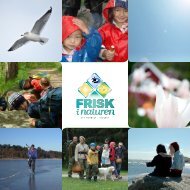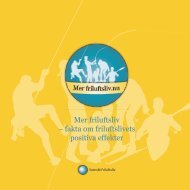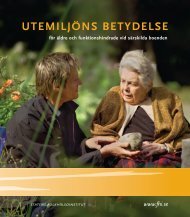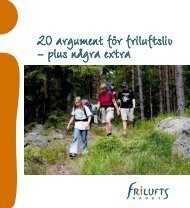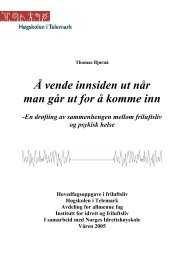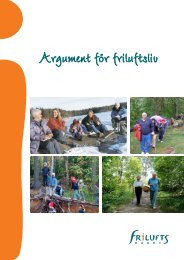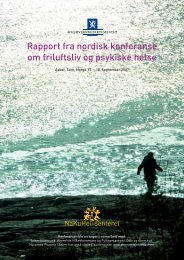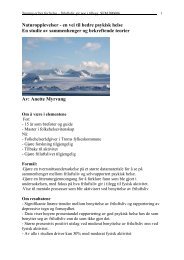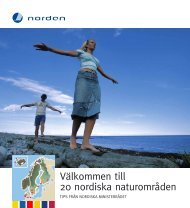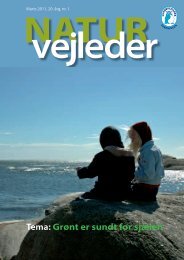Green Care: A Conceptual Framework - Frisk i naturen
Green Care: A Conceptual Framework - Frisk i naturen
Green Care: A Conceptual Framework - Frisk i naturen
Create successful ePaper yourself
Turn your PDF publications into a flip-book with our unique Google optimized e-Paper software.
For some care farms it is the noticeable absence of a ‘care’ or ‘institutional’<br />
element and the presence of a working, commercial farm with the farmer,<br />
farmer’s family and staff that are the constituents of successful social<br />
rehabilitation for participants (Hassink et al, 2007). Yet the situation at<br />
other care farms may be more ‘care’ and ‘carer’ oriented with the farming<br />
element present primarily to produce benefits for clients rather than for<br />
commercial agricultural production.<br />
4.2 Animals in green care<br />
Animal-Assisted Interventions (AAI) is the general term used for a variety<br />
of ways of utilising animals in the rehabilitation or social care of humans<br />
(Kruger and Serpell, 2006). This could involve pure therapy or including<br />
the animals in various activities. Animal-Assisted Therapy (AAT) is the<br />
term used for a goal-directed intervention in which an animal that satisfies<br />
certain criteria is an integral part of the treatment process for a particular<br />
human client, a process which is directed, documented and evaluated by<br />
professionals. Animal-Assisted Activities (AAA) is used for a less controlled<br />
service that may have a therapeutic effect, but which is not a true therapy in<br />
a strict sense. Both health personnel and lay persons can be involved.<br />
The therapeutic role of companion animals is well established for<br />
physically ill people, those with psychiatric disorders, emotionally<br />
disturbed people, prisoners, drug addicts, the elderly and children. The<br />
evidence has recently been reviewed by Fine (2006). Contact with<br />
companion animals is associated with positive changes in cardiovascular<br />
functioning and concentration of various neurotransmitters, reduction in<br />
psychosomatic disorders and afflictions and fewer visits per year to the<br />
doctor amongst the elderly. Friedmann et al (1980) revealed a relationship<br />
between owning a dog or cat and increased probability of survival one year<br />
after myocardial infarctions or severe angina pectoris. While 28% of nonowners<br />
died within one year, only 5.7% of pet owners died. Later research<br />
has confirmed this (Friedmann and Thomas, 1995).<br />
It is hypothesized that social support (defined by Cobb (1976) as an<br />
interpersonal relationship that leads to “the person’s belief that he is cared<br />
for, loved, esteemed, and a member of a network of mutual obligations”<br />
p. 300) acting as a buffer against stress responses or illness can be<br />
derived not only from human relationships, but also from a human-animal<br />
38 <strong>Green</strong> <strong>Care</strong>: A <strong>Conceptual</strong> <strong>Framework</strong>



